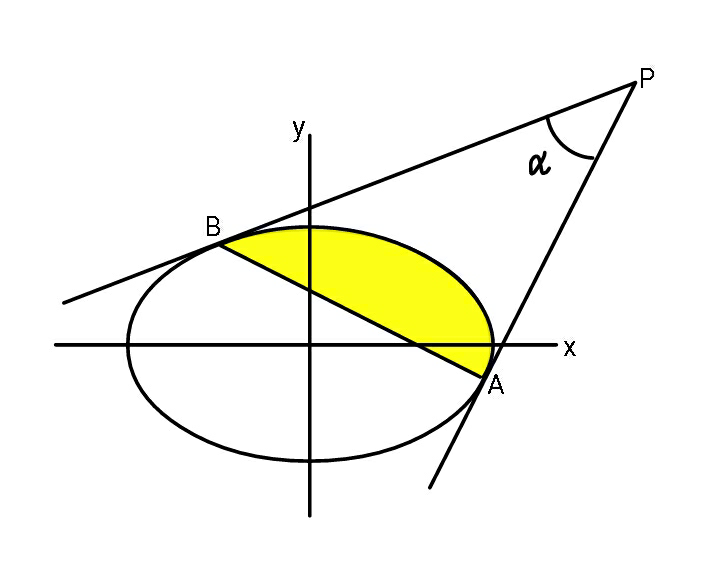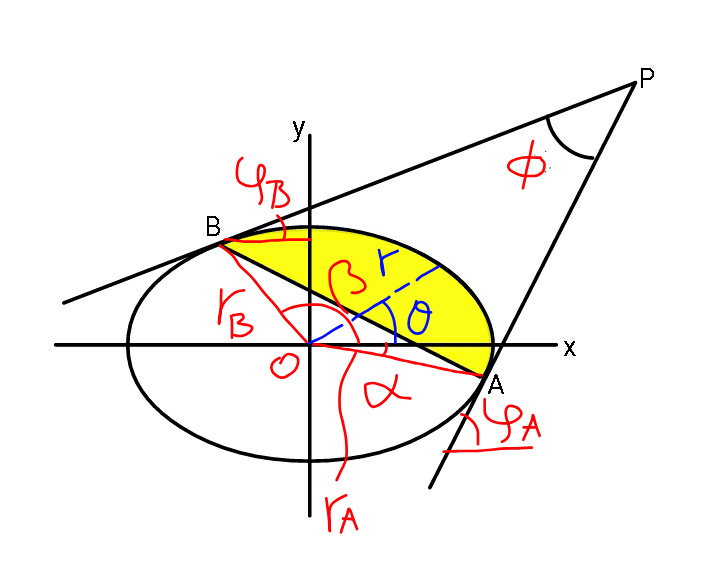
Question and Answers Forum
Question Number 60788 by ajfour last updated on 25/May/19

Commented by ajfour last updated on 25/May/19

Answered by mr W last updated on 27/May/19
![α in diagram will be replaced by ∅. let μ=(a/b)≥1 (x^2 /a^2 )+(y^2 /b^2 )=1 ((r^2 cos^2 θ)/a^2 )+((r^2 sin^2 θ)/b^2 )=1 ⇒r^2 =((a^2 b^2 )/(a^2 sin^2 θ+b^2 cos^2 θ)) ((2x)/a^2 )+((2yy′)/b^2 )=0 ((r cos θ)/a^2 )+((r sin θy′)/b^2 )=0 ⇒y′=tan ϕ=−(a^2 /(b^2 tan θ))=−(μ^2 /(tan θ)) at A: r_A , θ_A =α, ϕ_A at B: r_B , θ_A =β, ϕ_B tan ϕ_A =−(a^2 /(b^2 tan α)) tan ϕ_B =−(a^2 /(b^2 tan β)) ∅=ϕ_A −ϕ_B tan ∅=tan (ϕ_A −ϕ_B )=((−(a^2 /(b^2 tan α))+(a^2 /(b^2 tan β)))/(1+(a^4 /(b^4 tan α tan β)))) ⇒tan ∅=((a/b))^2 ((tan α−tan β)/(((a/b))^4 +tan α tan β)) ⇒tan ∅=μ^2 ((tan α−tan β)/(μ^4 +tan α tan β)) A=shaded area A=∫_θ_A ^θ_B ((r^2 dθ)/2)−((r_A r_B sin (θ_B −θ_A ))/2) A=(1/2)∫_α ^β ((a^2 b^2 dθ)/(a^2 sin^2 θ+b^2 cos^2 θ))−((sin (β−α))/2)(√(((a^2 b^2 )/(a^2 sin^2 α+b^2 cos^2 α))×((a^2 b^2 )/(a^2 sin^2 β+b^2 cos^2 β)))) A=((a^2 b^2 )/2)∫_α ^β (dθ/(a^2 sin^2 θ+b^2 cos^2 θ))−((a^2 b^2 sin (β−α))/2)(√(1/((a^2 sin^2 α+b^2 cos^2 α)(a^2 sin^2 β+b^2 cos^2 β)))) A=((ab)/2)[tan^(−1) (((a tan β)/b))−tan^(−1) (((a tan α)/b))]−((a^2 b^2 sin (β−α))/(2b^2 ))(√(1/((μ^2 sin^2 α+cos^2 α)(μ^2 sin^2 β+cos^2 β)))) A=((ab)/2)[tan^(−1) (μ tan β)−tan^(−1) (μ tan α)]−((μ sin (β−α))/2)(√(1/((μ^2 sin^2 α+cos^2 α)(μ^2 sin^2 β+cos^2 β)))) A=((ab)/2){[tan^(−1) (μ tan β)−tan^(−1) (μ tan α)]−((μ sin (β−α))/(√((μ^2 sin^2 α+cos^2 α)(μ^2 sin^2 β+cos^2 β))))} =((ab)/2)×f ⇒f=tan^(−1) (μ tan β)−tan^(−1) (μ tan α)−((μ sin (β−α))/(√((μ^2 sin^2 α+cos^2 α)(μ^2 sin^2 β+cos^2 β)))) ⇒f=tan^(−1) [((μ(tan β−tan α) )/(1+μ^2 tan β tan α))]−((μ(tan β−tan α))/(√((1+μ^2 tan^2 α)(1+μ^2 tan^2 β)))) let p=μ tan α, q=μ tan β ⇒f=tan^(−1) (((q−p)/(1+qp)))−((q−p)/(√((p^2 +1)(q^2 +1)))) ...(i) tan ∅=μ^3 ×((μ tan α−μ tan β)/(μ^6 +μ^2 tan α tan β)) ((tan ∅)/μ^3 )=((p−q)/(μ^6 +pq )) tan ∅ μ^6 +tan ∅ pq=μ^3 p−μ^3 q ⇒q=((μ^3 (p−μ^3 tan ∅))/(μ^3 +p tan ∅)) ...(ii)](Q60843.png)
Commented by ajfour last updated on 27/May/19

Commented by mr W last updated on 27/May/19

Answered by ajfour last updated on 27/May/19
![r=((ab)/(√(a^2 sin^2 θ+b^2 cos^2 θ))) A=∫_δ ^( δ+ξ) ((r^2 dθ)/2)−(1/2)r_A r_B sin ξ ((xcos δ)/a)+((ysin δ)/b)=1 ⇒ m_A =−(b/(atan δ)) m_B =−(b/(atan (δ+ξ))) tan α=((−(b/a)[(1/(tan δ))−(1/(tan (δ+ξ)))])/(1+(b^2 /(a^2 tan δtan (δ+ξ))))) ⇒ a^2 tan αtan δtan (δ+ξ)+b^2 tan α = ab[tan (δ+ξ)−tan δ] ⇒ tan (δ+ξ)=(b/a)(((btan α+atan δ)/(b−atan αtan δ))) ξ(δ)=tan^(−1) {(b/a)(((btan α+atan δ)/(b−atan αtan δ)))}−δ A=∫_δ ^( δ+ξ(δ)) ((r^2 dθ)/2)−(1/2)r_δ r_(δ+ξ(δ)) sin ξ(δ) (dA/dδ)=0 should yield a suitable 𝛅.](Q60929.png)
